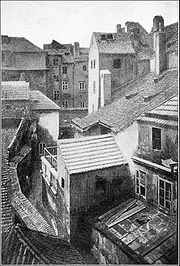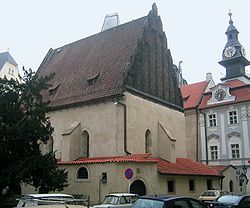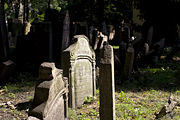
Josefov (Prague)
Encyclopedia


Cadastre
A cadastre , using a cadastral survey or cadastral map, is a comprehensive register of the metes-and-bounds real property of a country...
area of Prague
Prague
Prague is the capital and largest city of the Czech Republic. Situated in the north-west of the country on the Vltava river, the city is home to about 1.3 million people, while its metropolitan area is estimated to have a population of over 2.3 million...
, today Czech Republic
Czech Republic
The Czech Republic is a landlocked country in Central Europe. The country is bordered by Poland to the northeast, Slovakia to the east, Austria to the south, and Germany to the west and northwest....
, formerly the Jewish ghetto of the town. It is completely surrounded by Old Town
Old Town, Prague
Old Town is a medieval settlement of Prague, Czech Republic. It was separated from the outside by a semi-circular moat and wall, connected to the Vltava at both of its ends. The moat is now covered up by the streets Revolučni, na Příkopě, and Národni—which remain the official boundary of the...
. The quarter is often represented by the flag of Prague's Jewish community
Jews of Prague
The Jewish community of Prague is one of Central Europe's oldest and most well-known Jewish communities.-Basic Overview:...
, a yellow Magen David (Star of David
Star of David
The Star of David, known in Hebrew as the Shield of David or Magen David is a generally recognized symbol of Jewish identity and Judaism.Its shape is that of a hexagram, the compound of two equilateral triangles...
) on a red field.
History
Jews are believed to have settled in Prague as early as the 10th century. The first pogrom was in 1096 (the first crusade) and eventually they were concentrated within a walled GhettoGhetto
A ghetto is a section of a city predominantly occupied by a group who live there, especially because of social, economic, or legal issues.The term was originally used in Venice to describe the area where Jews were compelled to live. The term now refers to an overcrowded urban area often associated...
. In 1262 Přemysl Otakar II issued a Statuta Judaeorum which granted the community a degree of self administration. In 1389 one of the worst pogrom
Pogrom
A pogrom is a form of violent riot, a mob attack directed against a minority group, and characterized by killings and destruction of their homes and properties, businesses, and religious centres...
s saw some 1,500 massacred at Easter Sunday. The ghetto
Ghetto
A ghetto is a section of a city predominantly occupied by a group who live there, especially because of social, economic, or legal issues.The term was originally used in Venice to describe the area where Jews were compelled to live. The term now refers to an overcrowded urban area often associated...
was most prosperous towards the end of the 16th century when the Jewish Mayor, Mordecai Maisel, became the Minister of Finance and a very wealthy man. His money helped develop the ghetto. Around this time the Maharal was supposed to create the Golem
Golem
In Jewish folklore, a golem is an animated anthropomorphic being, created entirely from inanimate matter. The word was used to mean an amorphous, unformed material in Psalms and medieval writing....
.
In 1850 the quarter was renamed "Josefstadt" (Joseph's City) after Joseph II, Holy Roman Emperor who emancipated Jews with the Toleration Edict
Patent of toleration
The Patent of Toleration was an edict issued in 1781 by the Holy Roman Emperor, Joseph II of Austria. The Patent extended religious freedom to non-Catholic Christians living in Habsburg lands, including Lutherans, Calvinists, and the Greek Orthodox. Specifically, these members of minority faiths...
in 1781. Two years before Jews were allowed to settle outside of the city, so the share of the Jewish population in Josefov decreased, while only orthodox and poor Jews remained living there.
Most of the quarter was demolished between 1893 and 1913 as part of an initiative to model the city on Paris
Paris
Paris is the capital and largest city in France, situated on the river Seine, in northern France, at the heart of the Île-de-France region...
. What was left were only six synagogues, the old cemetery, and the Old Jewish Town Hall (now all part of the Jewish Museum in Prague
Jewish Museum in Prague
The Jewish Museum in Prague is a museum of Jewish heritage located in Prague, Czech Republic.The Jewish Museum in Prague was founded in 1906 by historian Dr. Hugo Lieben and Dr. Augustin Stein, who later became head of the Prague Jewish Community...
and described below).
With only six synagogues, the old cemetery, and the Old Jewish Town Hall the Nazi German occupation could have been expected to complete the demolition of the old ghetto. However the area was preserved in order to provide a site for a planned "exotic museum of an extinct race". This meant that the Nazis gathered Jewish artifacts from all over central Europe for display in Josefov.
Currently Josefov is overbuilt with buildings from the beginning of the 20th century, so it is difficult to appreciate exactly what the old quarter was like when it was reputed to have over 18,000 inhabitants.
Historical sites

- Franz Kafka'sFranz KafkaFranz Kafka was a culturally influential German-language author of short stories and novels. Contemporary critics and academics, including Vladimir Nabokov, regard Kafka as one of the best writers of the 20th century...
birthplace. - High SynagogueHigh Synagogue, PragueHigh Synagogue was financed by Mordechai Maisel, and it was finished in 1568, the same year as the Jewish Town Hall. The house was designed by P. Roder in Renaissance style . It was designed as a preaching place for councilors of Jewish town hall. In the center there were bimah, surrounded by seats...
(Vysoká synagoga): 16th century synagogue. - Jewish Town HallJewish Town Hall, PragueThe Jewish Town Hall in Josefov, Prague, was constructed adjacent to the Old New Synagogue on the corner of Maiselova and Červená Ulice in 1586 in Renaissance style under the sponsorship of Mayor Mordechai Maisel. It acquired its Rococo facade in the 18th century. The building was the main meeting...
(Židovská radnice): 18th century rococoRococoRococo , also referred to as "Late Baroque", is an 18th-century style which developed as Baroque artists gave up their symmetry and became increasingly ornate, florid, and playful...
town hall. - Klaus Synagogue (Klausova synagoga): 16th century baroqueBaroqueThe Baroque is a period and the style that used exaggerated motion and clear, easily interpreted detail to produce drama, tension, exuberance, and grandeur in sculpture, painting, literature, dance, and music...
synagogue. - Maisel Synagogue (Maiselova synagoga): 16th century synagogue destroyed by fire, now used as a museum.
- Pinkas Synagogue (Pinkasova synagoga): 16th century synagogue, now a memorial to Holocaust victims.
- Spanish Synagogue (Španělská synagoga): 19th century synagogue with Moorish interior.
- Old Jewish Cemetery (Starý židovský hřbitov): 15th-18th century cemetery. Europe's oldest surviving Jewish cemetery.
- Old New Synagogue (Staronová synagoga): 13th century GothicGothic architectureGothic architecture is a style of architecture that flourished during the high and late medieval period. It evolved from Romanesque architecture and was succeeded by Renaissance architecture....
synagogue. - Jewish Ceremonial Hall, PragueJewish Ceremonial Hall, PragueThe Jewish Ceremonial Hall can be found in the Josefov or Jewish Quarter of Prague, the capital of the Czech Republic. It was built in 1911-12 under the direction of architect J. Gerstl for the Jewish Burial Society and is in the neo-Romanesque style...
(Obřadní síň): 20th century neo-renaissanceNeo-RenaissanceRenaissance Revival is an all-encompassing designation that covers many 19th century architectural revival styles which were neither Grecian nor Gothic but which instead drew inspiration from a wide range of classicizing Italian modes...
hall.

